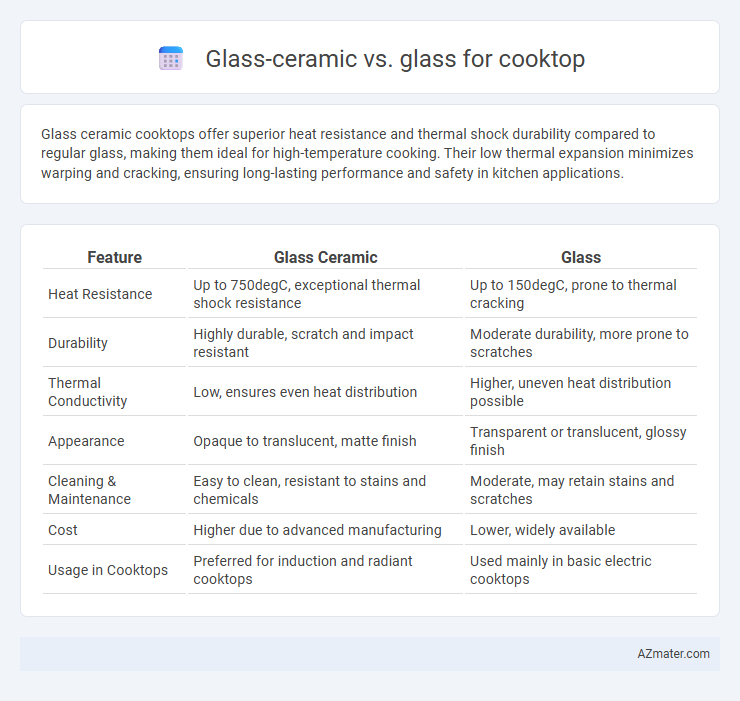Glass ceramic cooktops offer superior heat resistance and thermal shock durability compared to regular glass, making them ideal for high-temperature cooking. Their low thermal expansion minimizes warping and cracking, ensuring long-lasting performance and safety in kitchen applications.
Table of Comparison
| Feature | Glass Ceramic | Glass |
|---|---|---|
| Heat Resistance | Up to 750degC, exceptional thermal shock resistance | Up to 150degC, prone to thermal cracking |
| Durability | Highly durable, scratch and impact resistant | Moderate durability, more prone to scratches |
| Thermal Conductivity | Low, ensures even heat distribution | Higher, uneven heat distribution possible |
| Appearance | Opaque to translucent, matte finish | Transparent or translucent, glossy finish |
| Cleaning & Maintenance | Easy to clean, resistant to stains and chemicals | Moderate, may retain stains and scratches |
| Cost | Higher due to advanced manufacturing | Lower, widely available |
| Usage in Cooktops | Preferred for induction and radiant cooktops | Used mainly in basic electric cooktops |
Introduction to Cooktop Materials
Glass ceramic cooktops feature a specialized crystalline structure that offers superior heat resistance and even heat distribution compared to standard glass cooktops, which are typically made from tempered glass. Glass ceramic's advanced thermal properties reduce the risk of cracking under high temperatures, while maintaining a smooth surface for easy cleaning and durability. Standard glass cooktops, although affordable, tend to be less heat-resistant and more prone to scratches and thermal shock, making glass ceramic the preferred choice for high-performance cooking appliances.
What is Glass Ceramic?
Glass ceramic is a specialized material composed of crystalline and glassy phases, engineered to withstand extreme temperature changes without cracking, making it ideal for cooktops. Unlike traditional glass, glass ceramic offers superior thermal shock resistance, ensuring efficient heat distribution and durability during cooking. This material's unique structure allows for sleek, smooth surfaces that are easy to clean and maintain, enhancing both functionality and aesthetics in modern kitchen appliances.
What is Standard Glass?
Standard glass used in cooktops is typically soda-lime glass, known for its affordability and basic heat resistance but limited in thermal shock tolerance compared to glass ceramic. Glass ceramic cooktops are made from crystallized glass materials like Pyroceram, which can withstand rapid temperature changes up to 700degC without cracking. The superior thermal stability of glass ceramic makes it a preferred choice for high-performance cooking surfaces, offering durability and even heat distribution.
Heat Resistance Comparison
Glass ceramic cooktops withstand temperatures up to 700degC (1292degF) due to their crystalline structure, making them highly heat resistant and ideal for direct contact with hot cookware. In contrast, standard glass cooktops tolerate significantly lower temperatures, often around 150-250degC (302-482degF), limiting their durability under intense heat. The superior thermal shock resistance of glass ceramic prevents cracking and warping during rapid temperature changes, enhancing safety and longevity in kitchen applications.
Durability and Strength: Glass Ceramic vs Glass
Glass ceramic cooktops offer superior durability and heat resistance compared to standard glass, withstanding rapid temperature changes without cracking. Their crystalline structure provides enhanced strength and scratch resistance, making them more resilient to daily wear and tear. In contrast, regular glass cooktops are more prone to thermal shock and surface damage, reducing their overall lifespan in demanding kitchen environments.
Thermal Shock Performance
Glass ceramic cooktops exhibit superior thermal shock performance compared to standard glass due to their crystalline structure, which provides enhanced resistance to sudden temperature changes. This material can withstand rapid heating and cooling cycles without cracking or warping, making it ideal for high-performance cooking surfaces. In contrast, regular glass is more susceptible to thermal stress, increasing the risk of breakage under extreme temperature fluctuations.
Aesthetic Differences and Design Options
Glass ceramic cooktops offer a sleek, matte finish that resists scratches and high temperatures, enhancing modern kitchen aesthetics with a smooth, consistent surface. In contrast, standard glass cooktops typically have a glossy, reflective appearance that may show fingerprints and smudges more easily, affecting overall visual appeal. Glass ceramic options often provide greater design flexibility with customizable colors and patterns, allowing homeowners to match diverse kitchen styles and create a cohesive look.
Cleaning and Maintenance Considerations
Glass ceramic cooktops offer smoother surfaces that resist staining and simplify cleaning, requiring only non-abrasive cleaners and a soft cloth to maintain their appearance. In contrast, traditional glass cooktops may be more prone to scratches and discoloration, demanding cautious cleaning methods to avoid damage. Regular maintenance of glass ceramic cooktops preserves their heat efficiency and sleek finish, making them a practical choice for easy upkeep in busy kitchens.
Cost Analysis: Glass Ceramic vs Glass
Glass ceramic cooktops typically have a higher upfront cost compared to traditional glass cooktops due to their enhanced heat resistance and durability. Maintenance expenses for glass ceramic surfaces are generally lower over time since they resist scratches and thermal shock better than standard glass. Long-term cost efficiency favors glass ceramic cooktops despite the initial investment, making them a preferred choice for frequent cooks seeking durability and performance.
Which Cooktop Material is Better?
Glass ceramic cooktops offer superior heat resistance and faster heat distribution compared to traditional glass, making them more durable and efficient for cooking. The tempered glass surface of glass ceramic is less prone to cracking under high temperatures and thermal shock, providing a safer and longer-lasting option. For optimal performance and longevity, glass ceramic materials outperform standard glass in cooktop applications.

Infographic: Glass ceramic vs Glass for Cooktop
 azmater.com
azmater.com